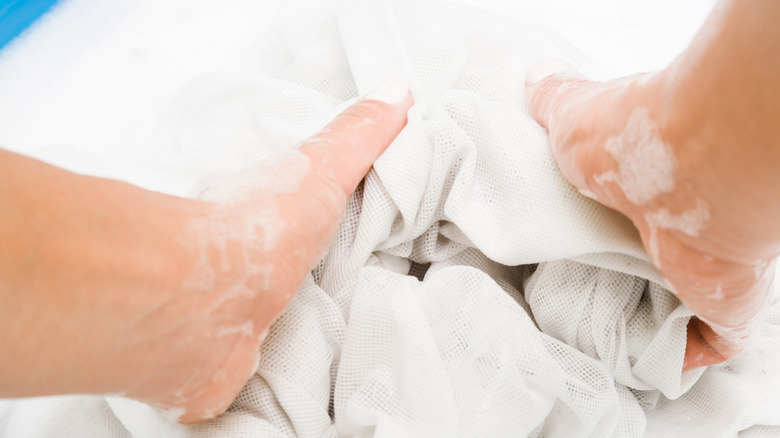The Type Of Curtains You Should Hand Wash (& The Best Way To Do It)
Curtains might not be something you think about washing often. How dirty can they get just hanging around all day? You might be surprised at how much dust and other airborne particles settle onto your curtains, though. Keeping them clean helps them look great, and it removes dirt, pollen, pet dander, and other potential allergens that could make your family sniffly and sneezy. Some curtains can go right into the washing machine for a quick refresh, but others should only be hand washed due to the delicate nature of their material. The latter group includes silk, lace, and sheer fabric curtains, which are all popular materials for more elegant designs. While you're at it, you can also hand wash fabrics like linen and cotton to reduce wear from the washing machine.
Cleaning your curtains the wrong way could destroy them completely, which is why it's essential to know if yours should be dry cleaned, machine washed, or hand washed. More durable fabrics, like cotton and polyester, hold up well in the washing machine on the gentle cycle with cold water, so you don't need to hand wash them unless you prefer that method. However, machine-washing delicate fabrics sometimes causes the material to shrink or stretch, resulting in misshapen curtains that can't be repaired. Some curtains usually can't be washed at home, even by hand, including velvet, satin, suede, and tapestry fabrics.
Hand wash curtains made of these fabrics
Checking the care label on your curtains is always the best place to start. No matter what fabric the curtains are made of, they may have specific care requirements that you should follow. It's also important to consider that lined curtains often have two different types of fabric on them. Even if the panel is made of machine-washable cotton, the lining could be made from fabric that needs to be hand-washed. The label provides that information for you to help you avoid making a washing mistake — it's the best way to tell if you really need to dry-clean the curtains or if you can wash them yourself.
Sheer curtains made from delicate fabrics like organza should be hand-washed to avoid damage. Machine-washing could tear the thin fabric. It's also possible for the curtain panels to get entangled or twisted around the agitator or around itself as it washes. Lace curtains should be hand-washed for the same reason.
And silk is an even bigger example of a material that should never be washed in a washing machine. Many silk curtains can be hand-washed at home, but watch out for others that are labeled as dry-clean only. Linen is a fabric that can go into a machine in some cases, but hand washing may be preferred to prevent excess wrinkling or shrinking. Unless the curtains are dry-clean-only, hand washing them is a safe option if you're concerned about their durability in the washing machine.
How to hand wash curtains correctly
Shake or vacuum your curtains first to get rid of the dust using a soft brush attachment. Then, fill a large bucket, sink, or bathtub with cold water. You want enough space to swish your curtains around freely in the water, so choose your container based on the size and thickness of the curtains. Add a small amount of detergent and agitate the water to make suds.
Submerge the curtains and swish the fabric through the water. Letting the curtains soak in the water for a few minutes can help loosen the dirt. Avoid squeezing or twisting motions that could distort the fabric — that's one of the biggest mistakes to avoid when hand-washing your laundry. When the curtains are clean, drain the dirty water and fill the container with clean, cold water. Swish the curtains to release the soap from the fabric. You may need to rinse the curtains a few times to get all of the suds out to prevent the fabric from feeling stiff when it dries.
Avoid the temptation to wring water out of the curtains once you're done rinsing them. Any twisting action could cause wrinkles or stretch the fabric. Instead, fold and press the curtains in the empty container. You can also press the panels between towels to remove excess water. Even low heat in a dryer could shrink or damage the fabric, so letting the curtains air dry is the best option. Ideally, you should lay the curtains flat while they dry. Hanging them up could cause them to stretch or become distorted due to the weight of the wet fabric.


